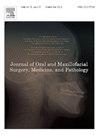Anti-BP230 type mucous membrane pemphigoid with desquamative gingivitis: A case report
IF 0.4
Q4 DENTISTRY, ORAL SURGERY & MEDICINE
Journal of Oral and Maxillofacial Surgery Medicine and Pathology
Pub Date : 2024-04-27
DOI:10.1016/j.ajoms.2024.04.013
引用次数: 0
Abstract
Mucous membrane pemphigoid (MMP) is an autoimmune subepithelial/subepidermal blistering disease characterized by linear deposition of immunoglobulin G (IgG), IgA, and/or C3 in the basement membrane zone (BMZ) and predominant mucosal lesions involving the oral cavity and conjunctivae. Here, we describe a case of a 58-year-old Japanese man with MMP. Intraoral examination revealed desquamative gingivitis in the upper and lower gingivae. No conjunctival or cutaneous lesions were observed. Histopathological examination revealed a subepithelial split with inflammatory cell infiltration of the epithelial and connective tissues. Direct immunofluorescence revealed a linear deposition of C3 in the BMZ. IgG autoantibodies against BP230 were detected using an enzyme-linked immunosorbent assay. Indirect immunofluorescence using 1 mol/L NaCl-split skin sections revealed no reactivity for serum IgG or IgA. Immunoblotting using normal human epidermal extract as a substrate did not detect IgG reactivity against the 230-kDa antigen. Based on the above results, the definitive diagnosis of MMP with anti-BP230 antibody alone was established. Our case was categorized as low-risk MMP. The patient was treated with 0.1% triamcinolone acetonide ointment, oral minocycline, and oral nicotinamide, which improved the oral erosions. However, the mechanism underlying IgG autoantibody production against intracellular BP230 remains unclear. Further research and more such case studies are necessary to elucidate the mechanism of anti-BP230 antibody production and the clinical feature of anti-BP230 type MMP.
抗 BP230 型粘膜丘疹并伴有脱屑性牙龈炎:病例报告
粘膜丘疹性类风湿(MMP)是一种自身免疫性上皮下/表皮下大疱性疾病,其特征是免疫球蛋白 G(IgG)、IgA 和/或 C3 在基底膜区(BMZ)线性沉积,主要粘膜病变涉及口腔和结膜。在此,我们描述了一例 58 岁的日本男性 MMP 患者。口腔内部检查发现,上牙龈和下牙龈出现脱屑性牙龈炎。未发现结膜或皮肤病变。组织病理学检查发现上皮下分裂,上皮和结缔组织有炎症细胞浸润。直接免疫荧光显示,C3在BMZ呈线状沉积。使用酶联免疫吸附试验检测到了针对 BP230 的 IgG 自身抗体。使用 1 mol/L NaCl 分层皮肤切片进行间接免疫荧光检测,未发现血清 IgG 或 IgA 反应。使用正常人表皮提取物作为底物进行免疫印迹,未检测到针对 230 kDa 抗原的 IgG 反应。根据上述结果,仅用抗 BP230 抗体就可明确诊断为 MMP。我们的病例被归类为低风险 MMP。患者接受了 0.1% 曲安奈德醋酸氨溴索软膏、口服米诺环素和口服烟酰胺的治疗,口腔糜烂有所改善。然而,针对细胞内 BP230 的 IgG 自身抗体产生的机制仍不清楚。要阐明抗 BP230 抗体产生的机制和抗 BP230 型 MMP 的临床特征,还需要进一步研究和更多此类病例研究。
本文章由计算机程序翻译,如有差异,请以英文原文为准。
求助全文
约1分钟内获得全文
求助全文
来源期刊

Journal of Oral and Maxillofacial Surgery Medicine and Pathology
DENTISTRY, ORAL SURGERY & MEDICINE-
CiteScore
0.80
自引率
0.00%
发文量
129
审稿时长
83 days
 求助内容:
求助内容: 应助结果提醒方式:
应助结果提醒方式:


